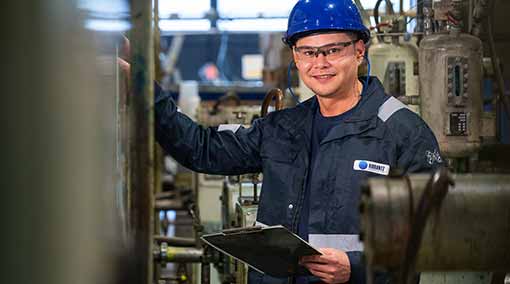We’re experts and innovators focused on solving challenges, embracing change and growing.
Q&A with Jana Shafer

How adaptable is Pearls to sectors beyond architectural and industrial coatings — for example, sealants, adhesives or construction materials?
While Pearls was originally developed for waterborne architectural and industrial coatings, the technology has proven to be highly versatile. Because Pearls is a universal, high-strength, pourable solid colorant (not tied to any single resin system), it can translate well across different chemistries. We always recommend validating performance within your specific formulation, but we’re already seeing very promising results in several alternative applications as customers begin exploring the technology more broadly.
What prompted Vibrantz to expand its solid colorant technology into building and construction applications?
Within our current possibilities, we have strived at every stage of the production process The expansion into building and construction was really driven by customer interest. Once customers were introduced to the Pearls platform, they quickly recognized that it could help address some longstanding challenges in the B&C space. This market has dealt with messy and labor-intensive dry pigment handling, and ongoing struggles with achieving consistent color from batch to batch or across different job sites and regions. There has also traditionally been a fairly limited color range, especially when it comes to deeper shades, along with general housekeeping and waste issues from powders.
Pearls offers a different approach by providing a controlled, pre-dispersed colorant that delivers repeatable performance at low dosages and much cleaner handling. It creates an opportunity to improve both color quality and operational efficiency in a segment that hasn’t seen many meaningful innovations in quite some time.
How does Pearls overcome the long-standing challenges of color inconsistency and limited color space in materials like grouts, mortars and cement?
Traditional granulated or raw pigments can be tough to work with because they don’t always disperse evenly, especially in low-shear environments. That’s where you start to see things like spotting or streaking in the final product. Pearls can avoid that issue because the pigments are already pre-dispersed and encapsulated, so they wet into the mix quickly and uniformly.
The result is no clumping, no uneven color development, and much tighter control over tint strength. It gives you repeatable, reliable color every time—whether you’re mixing a small batch in a shop or running large production volumes in a plant.
In what ways does the technology enhance both the darkest and lightest ends of the color spectrum for B&C materials?
When it comes to dark shades, Pearls perform well because of the high degree of pigment dispersion. You can get deep, saturated blacks and blues without having to overload the system, and without having to co-grind pigment directly into the cement mix. That means you can achieve those rich tones without introducing extra processing steps or compromising the material.
On the lighter end of the spectrum, the fine dispersion quality helps keep pastels and whites clean and bright, rather than muddy or grayish. So, you’re able to maintain clarity in the light tones just as effectively as depth in the dark ones.
In spaces where the color range has always been fairly limited, this really opens things up and gives manufacturers and designers a lot more freedom to explore both ends of the color palette.
With growing digitalization in manufacturing, how does Pearls fit into automated or smart dosing environments?
Pearls was really designed with automation in mind. Because it’s a free-flowing solid, it fits naturally into automated dosing environments—whether that’s gravimetric dosing, automated tint dispensers, or simple pre-measured drop-in packs. It also works well in closed or smart manufacturing systems, since it supports things like barcoded traceability and very precise, repeatable dosing.
Another advantage is shelf life. Pearls is incredibly stable; it doesn’t settle, separate, or dry out the way liquids can over time. That means it can sit on a shelf for long periods without any loss in performance, which is a big benefit for plants with variable production schedules.
So, as production moves further into automation, Pearls integrates smoothly while offering a cleaner, more consistent alternative to both liquid and powder pigments.
Looking ahead, how might Pearls technology redefine color and performance standards beyond the B&C market? Are there other markets or materials where you see this solid colorant format making an impact?
Right now, anywhere you have a waterborne system where color consistency and clean manufacturing are important, Pearls has a place. The technology is flexible, so if you can envision it, there’s a good chance we can make it work.
What’s really happening here is a shift in how the market approaches color. We’re moving away from treating color like a raw material that you hope disperses correctly, and toward treating it as a controlled, precise, repeatable input. A lot of the common frustrations we hear in the industry—batch variation, cleanup, handling issues—are significantly reduced with Pearls. It’s a different way of thinking about color, and it opens up opportunities that just weren’t practical before.





